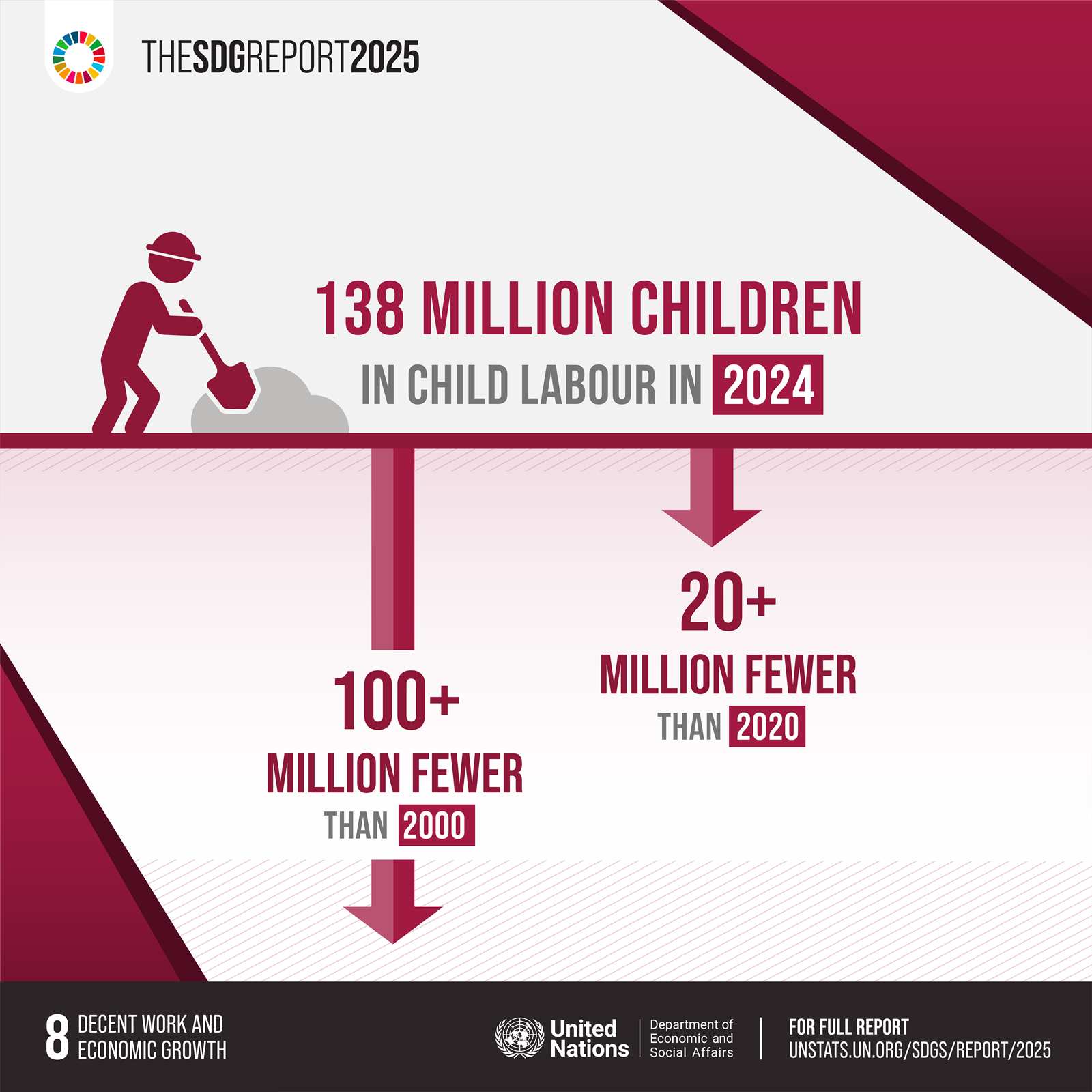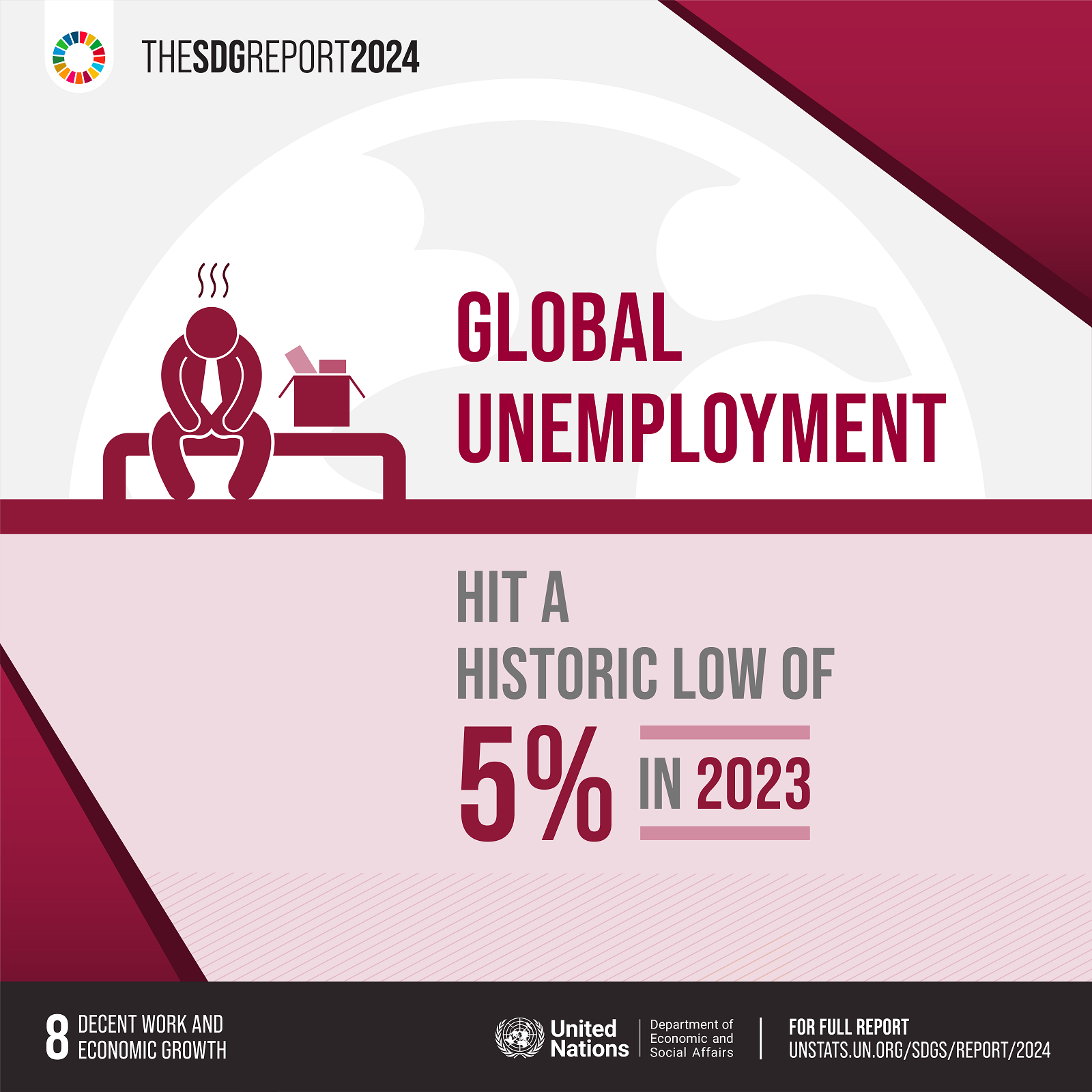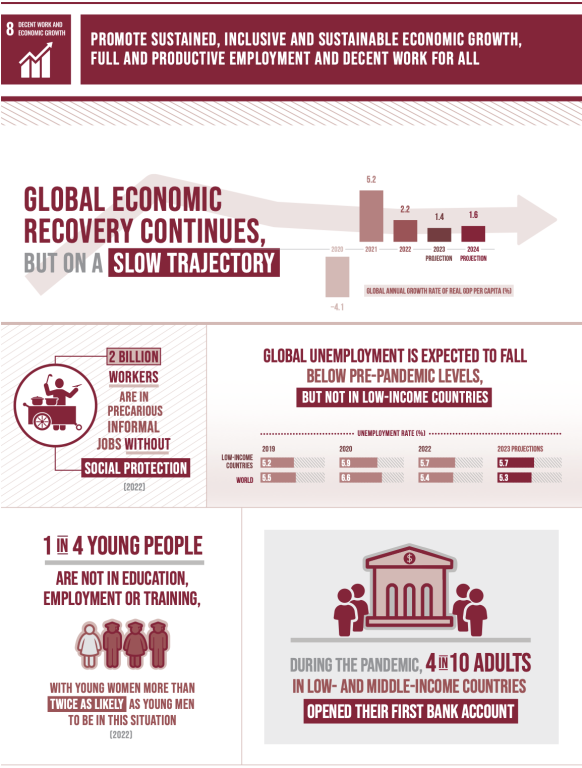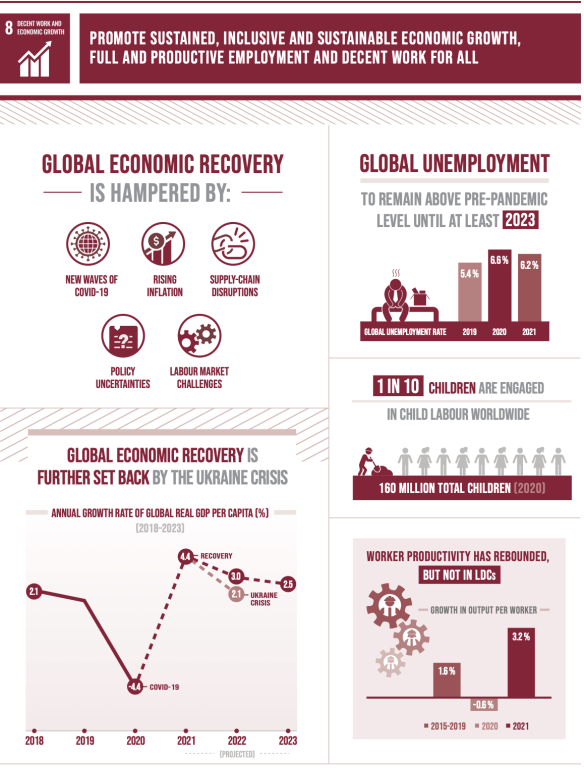
Green economy

Sustainable tourism

Employment, decent work for all and social protection
Targets and Indicators

8.1
Sustain per capita economic growth in accordance with national circumstances and, in particular, at least 7 per cent gross domestic product growth per annum in the least developed countries
8.1.1
Annual growth rate of real GDP per capita

8.2
Achieve higher levels of economic productivity through diversification, technological upgrading and innovation, including through a focus on high-value added and labour-intensive sectors
8.2.1
Annual growth rate of real GDP per employed person

8.3
Promote development-oriented policies that support productive activities, decent job creation, entrepreneurship, creativity and innovation, and encourage the formalization and growth of micro-, small- and medium-sized enterprises, including through access to financial services
8.3.1
Proportion of informal employment in total employment, by sector and sex

8.4
Improve progressively, through 2030, global resource efficiency in consumption and production and endeavour to decouple economic growth from environmental degradation, in accordance with the 10-Year Framework of Programmes on Sustainable Consumption and Production, with developed countries taking the lead
8.4.1
Material footprint, material footprint per capita, and material footprint per GDP
8.4.2
Domestic material consumption, domestic material consumption per capita, and domestic material consumption per GDP

8.5
By 2030, achieve full and productive employment and decent work for all women and men, including for young people and persons with disabilities, and equal pay for work of equal value
8.5.1
Average hourly earnings of female and male employees, by occupation, age and persons with disabilities
8.5.2
Unemployment rate, by sex, age and persons with disabilities

8.6
By 2020, substantially reduce the proportion of youth not in employment, education or training
8.6.1
Proportion of youth (aged 15-24 years) not in education, employment or training

8.7
Take immediate and effective measures to eradicate forced labour, end modern slavery and human trafficking and secure the prohibition and elimination of the worst forms of child labour, including recruitment and use of child soldiers, and by 2025 end child labour in all its forms
8.7.1
Proportion and number of children aged 5‑17 years engaged in child labour, by sex and age

8.8
Protect labour rights and promote safe and secure working environments for all workers, including migrant workers, in particular women migrants, and those in precarious employment
8.8.1
Fatal and non-fatal occupational injuries per 100,000 workers, by sex and migrant status
8.8.2
Level of national compliance with labour rights (freedom of association and collective bargaining) based on International Labour Organization (ILO) textual sources and national legislation, by sex and migrant status

8.9
By 2030, devise and implement policies to promote sustainable tourism that creates jobs and promotes local culture and products
8.9.1
Tourism direct GDP as a proportion of total GDP and in growth rate

8.10
Strengthen the capacity of domestic financial institutions to encourage and expand access to banking, insurance and financial services for all
8.10.1
(a) Number of commercial bank branches per 100,000 adults and (b) number of automated teller machines (ATMs) per 100,000 adults
8.10.2
Proportion of adults (15 years and older) with an account at a bank or other financial institution or with a mobile-money-service provider

8.a
Increase Aid for Trade support for developing countries, in particular least developed countries, including through the Enhanced Integrated Framework for Trade-Related Technical Assistance to Least Developed Countries
8.a.1
Aid for Trade commitments and disbursements

8.b
By 2020, develop and operationalize a global strategy for youth employment and implement the Global Jobs Pact of the International Labour Organization
8.b.1
Existence of a developed and operationalized national strategy for youth employment, as a distinct strategy or as part of a national employment strategy
Progress and Info
Over the past decade, progress on Goal 8 has been mixed. While there have been important gains, in particular in reducing unemployment and expanding financial access, setbacks from the coronavirus disease (COVID-19) pandemic and ongoing structural challenges have slowed or reversed gains in productivity, employment and worker protections – in particular for vulnerable groups and in the least developed countries and small island developing States. Just transitions to the formal sector –especially for women and youth – supported by stronger links to social protection systems, are essential to ensure sustainable livelihoods and reduce inequalities. Accelerated action is needed to build more inclusive, productive and resilient labour markets, strengthen protections for informal and migrant workers and advance green and digital economy initiatives that promote decent work. To support faster progress, the Secretary-General launched the Global Accelerator on Jobs and Social Protection for Just Transitions, which supports the expansion and consolidation of social protection systems and the creation of decent work opportunities. Another key effort is the United Nations initiative on the key transition relating to jobs and social protection, which helps governments to link employment and social protection policies to national development plans.
Target 8.1 - Global real GDP per capita grew modestly over the decade, rebounding after a sharp 3.8 per cent drop in 2020 owing to COVID-19. Growth peaked at 5.5 per cent in 2021 but slowed to 1.9 per cent in 2023, with a modest 2.0 per cent estimated for 2024 and 1.5 per cent projected for 2025. The least developed countries experienced more volatility, with the real GDP growth falling to just 0.5 per cent in 2020 and recovering to 4.7 per cent in 2022 before slowing again to 3.5 per cent in 2023 and an estimated 3.1 per cent in 2024.
Target 8.2 - Labour productivity, measured as GDP per worker, rebounded to 1.5 per cent growth in 2024 after near stagnation in the 2022–2023 period. The pandemic severely impacted productivity in 2020, when output fell faster than employment rates. Despite a rebound in 2021, growth has struggled to return to pre-pandemic levels.
Target 8.3 - In 2024, 57.8 per cent of the global workforce was in informal employment, lacking social security or legal protection. This marks a 0.2 percentage point increase from the previous year, adding 34 million informal workers.
Target 8.5 - The global unemployment rate reached a record low of 5.0 per cent in 2024, down from 6.0 per cent in 2015. However, despite improvements since 2015, women and youth continue to face higher unemployment rates, with youth still three times more likely to be unemployed than adults.
Target 8.6 - In 2024, one in five young people (ages 15–24) worldwide was not in employment, education or training, missing opportunities to gain skills or work experience. Young women are more than twice as likely to be as young men not to be in employment, education or training.
Target 8.8 - The global average compliance with labour rights deteriorated by 7 per cent from 2015 to 2023, with the steepest erosion occurring in the least developed countries (a 45.4 per cent decline). Developed economies also saw a 16.5 per cent decline. Ongoing violations undermine free and independent employers’ and workers’ organizations and increasingly shrink civic space.

For more information, please visit: https://unstats.un.org/sdgs/report/2025/
More details on SDG 8 in 2025: https://unstats.un.org/sdgs/report/2025/Goal-08/
The 2025 Extended Report on SDG 8 can be found here: https://unstats.un.org/sdgs/report/2025/extended-report/Extended-Report-2025_Goal-8.pdf









